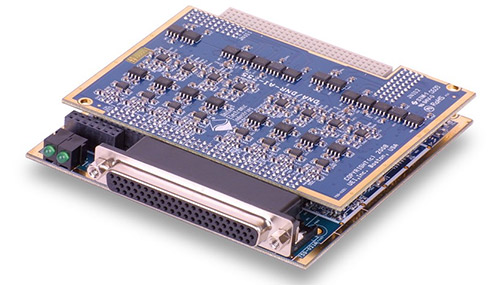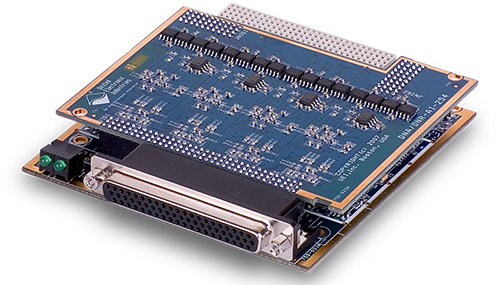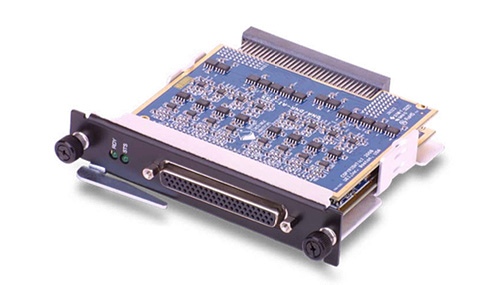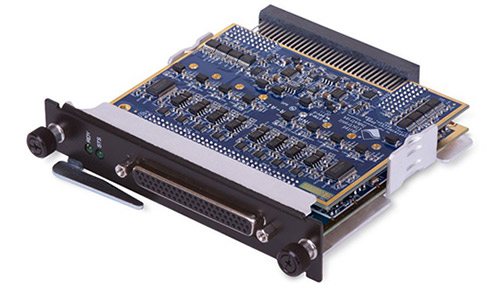
2-Channel, 16-bit, Synchro/Resolver Interface
DNx-AI-255

4-Channel, 16-bit, LVDT/RVDT Interface
DNx-AI-254

2-Channel Synchro/Resolver Interface
DNx-AI-255-815
General
(508) 921-4600
Email Sales
Email Support
UEI Europe Office
+49 40 63698136
Email EU Sales
Visit this page for local offices and distributors.

The DNx-AI-256 are high performance, two channel synchro/resolver input and output boards compatible with UEI's powerful Cube, RACKtangle and FLATRACK I/O chassis. The 256 series boards are functionally similar to the DNx-AI-255 but provide significantly more output drive for applications that require it. The DNx-AI-256 series is also an ideal solution for simulating LVDT/RVDTs. The board may be configured as two inputs, two outputs, or one input and one output.
The board provides 2 input channels that will monitor either 3-wire synchros or 4-wire resolvers. The board's high precision circuitry, combined with each channel's independent 16-bit A/D converter, allows measurement accuracies up to ± 2.6 arc-minute. The inputs may be read at rates up to the excitation frequency (10 kHz max).
Each channel provides its own programmable reference, with outputs independently programmable up to 19.8 Vrms at frequencies from 50 to 10 kHz and up to 2.4 VA. When using external references, the DNx-AI-256 automatically adjusts simulated outputs for variable amplitude and frequency references in one reference cycle.
The DNx-AI-256 also provides two channels of synchro or resolver output that are ideal for driving such items as attitude indicators or as a test source for a wide variety of synchro or resolver input devices. The outputs each accept an independent reference signal and offer 16-bit output resolution. Each channel will drive up to 19.8 Vrms at 3.0 VA (total board output must be less than or equal to 5 VA) without external buffering. The current consumed by each output channel may be monitored and used to confirm the wiring is correct and the coils of the synchro/resolver or RVDT/LVDT are as expected.
The board offers 350 Vrms of isolation between channels as well as between the I/O connections and the chassis. Like all PowerDNA/UEILogger I/O boards, the DNx-AI-256 offers operation in harsh environments and has been tested to 5 g vibration, 100 g shock, -40 to +85 °C temperatures, and altitudes up to 70,000 feet.
Software is included, providing a comprehensive, yet easy-to-use API that supports all popular operating systems, including Windows, Linux, and most real-time operating systems—such as QNX, Intime, VXworks, and more. Additionally, the UEIDAQ Framework—an even higher level Windows driver—supplies complete support for those creating applications in many popular Windows programming languages, as well as data acquisition software packages such as LabVIEW and MATLAB/Simulink.
With the high power output of the DNR-AI-256, a fan unit should be placed in the slot next to it to prevent overheating. The fan unit, DNR-FAN-925, is included with the DNR-AI-256.
Engineers employ UEI hardware to test, measure and control synchro, resolver, and VDTs for their applications. Our flexible IO boards can support Star or Delta wiring configurations as well as a wide range of voltages and frequencies. #helicopter #military #gyroscope #avionics #simulation #Labview #simulink #matlab
Learn more about synchro/resolvers: https://www.ueidaq.com/synchro-resolver-tutorial
UEI Synchro/Resolver & VDT IO options:
• 4-Channel, 16-bit, LVDT/RVDT Interface: https://www.ueidaq.com/products/4-channel-16-bit-lvdt-rvdt-interface
• 2-Channel, 16-bit, Synchro/Resolver Interface: https://www.ueidaq.com/products/2-channel-16-bit-synchro-resolver-interface
• 2-Channel High Output Drive Synchro/Resolver/LVDT/RVDT Interface: https://www.ueidaq.com/products/2-channel-high-output-drive-synchro-resolver-lvdt-rvdt-interface
In this webinar, UEI application engineers cover how LVDT and RVDT devices work, and how to interface with them using our DNx-AI-254 LVDT/RVDT Interface Board. #linear #rotary #transformer #input #simulator #card #hardware #guide
Learn more about the DNx-AI-254 at https://www.ueidaq.com/product...
Learn more about UEI's LVDT/RVDT solutions at https://www.ueidaq.com/lvdt-rv...
Explore UEI's Technical Master Class series: https://youtube.com/playlist?l...
We show you how to quickly configure LabVIEW to receive data from a United Electronic Industries synchro/resolver I/O module. In this example, the module is measuring the position of an aircraft thruster and passing along the data to the LabVIEW software running on a standard PC laptop. #aviation #avionics #IO #demo
Learn more about UEI's synchro/resolver and LVDT/RVDT boards at http://www.ueidaq.com/data-acq...
Explore UEI's software and programming options at https://www.ueidaq.com/support...
UEI engineers explains the troubleshooting process UEI's engineering team used to evaluate an erratic flap indicator using an AI-256. #hardware #debugging #diagnostics #lvdt #rvdt #resolver #demo
Learn more about the AI-256 at https://www.ueidaq.com/product...
Explore UEI's synchro/resolver system solutions at https://www.ueidaq.com/synchro...
We show you how to quickly configure LabVIEW to receive data from a United Electronic Industries synchro/resolver I/O module. In this example, the module is measuring the position of an aircraft thruster and passing along the data to the LabVIEW software running on a standard PC laptop. #aviation #avionics #IO #demo
Learn more about UEI's synchro/resolver and LVDT/RVDT boards at http://www.ueidaq.com/data-acq...
Explore UEI's software and programming options at https://www.ueidaq.com/support...